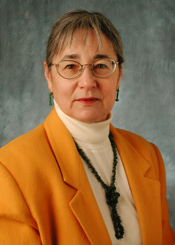
Lise Menn
Linguistics
University of Colorado
lise.menn@Colorado.EDU

|
Lise Menn Linguistics University of Colorado lise.menn@Colorado.EDU |
| Participants: | 4 |
| Type of Study: | 3 Telerounds seminars on pragmatics, 1 individual at home with 2 graduate students |
| Location: | USA |
| Media type: | video |
| DOI: | doi:10.21415/T5DW3W |
The ED and GW files, although they were not part of the publications listed below, nicely replicated the empathy findings for people with aphasia that were reported in these two published articles:
Menn, L., Reilly, K.F., Hayashi, M., Kamio, A., Fujita, & Sasanuma, S. (1998). The interaction of preserved pragmatics and impaired syntax in Japanese and English aphasic speech. Brain and Language, 61: 183-225.
Menn, L., Kamio, A., Hayashi, M., Fujita, I., Sasanuma, S., & Boles, L. (1999). The role of empathy in sentence production: A functional analysis of aphasic and normal elicited narratives in Japanese and English. In A. Kamio & K. Takami (Eds.), Function and structure. Amsterdam: John Benjamins. pp. 317-355.
Lise Menn made the videos of ED, EG, and GW for a Telerounds seminar on pragmatics in aphasia. They are non-fluent aphasic speakers, well past the acute stage, who were at the University of Arizona Speech and Hearing Clinic. The goal was to demonstrate that very normal pragmatic effects of animacy/empathy interacted with their limited syntax to produce qualitatively different responses when the action affected an inanimate object (leading to a preference for active-voice sentences) and when the action affected an animate object (leading to an attempt at passive-voice sentences, which were likely to fall apart).
S.K., the subject of the sk videos, was the co-author, with Lise Menn, of “Shirley Says: Living with Aphasia”, posted online at spot.colorado.edu/~menn/. She did not want to be anonymous, and her name is listed on the publication as a co-author.
She was videotaped in her home with Lise Menn and two graduate students. The purpose of the video was to show students in linguistics classes how impressively sharp she was mentally, in spite of her impaired language. She was a classic Broca's aphasic, long past the acute stage, and she is patient 'S.K.' in Menn publications from 1990 on.
She was about 70 years old in the video. Her education included two years of business school, and she had worked, primarily as the bookkeeper, in a small business with her husband. Her first language was Yiddish; she learned English by immersion when she started school and (presumably) from other children, so she was a near-native speaker of English. She had been able to do New York Times crossword puzzles before her stroke, which occurred during surgery to remove plaque from her carotid artery.